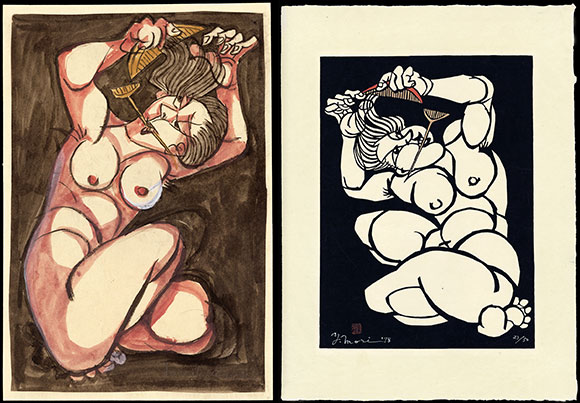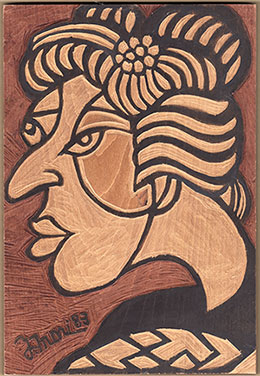

MORI Yoshitoshi (森義利)
|
 Mori Yoshitoshi (森義利 1898-1992) was born in Tokyo and graduated from the Kawabata School of Fine Arts. He studied stencil dyeing with Yanagi Sôetsu (柳宗悦 1889-1961), a philosopher who helped establish the Mingei (folk crafts: 民芸) movement in the late 1920s and 1930s. Mori also studied with the textile designer, leading member of the mingei movement, and ningen kokuhô (Living National Treasure: 人間国宝 in 1956) Serizawa Keisuke (芹沢銈介 1895-1984). Mori produced tapestries in the 1940s that he entered into exhibitions, and began making monotype stencil prints from wooden blocks and glass sheets in 1951. He first exhibited prints on paper in 1954, encouraged by Yanagi.
Mori Yoshitoshi (森義利 1898-1992) was born in Tokyo and graduated from the Kawabata School of Fine Arts. He studied stencil dyeing with Yanagi Sôetsu (柳宗悦 1889-1961), a philosopher who helped establish the Mingei (folk crafts: 民芸) movement in the late 1920s and 1930s. Mori also studied with the textile designer, leading member of the mingei movement, and ningen kokuhô (Living National Treasure: 人間国宝 in 1956) Serizawa Keisuke (芹沢銈介 1895-1984). Mori produced tapestries in the 1940s that he entered into exhibitions, and began making monotype stencil prints from wooden blocks and glass sheets in 1951. He first exhibited prints on paper in 1954, encouraged by Yanagi.
A pivotal incident took place in 1957 that was both a disappointment and a triumph for Mori. Eight hundred prints by 250 artists from around the world were entered into the First International Biennial of Prints in Tokyo. The judges were from France, Spain, West Germany, Israel, and Japan. Dissension ensued, with the Japanese judges favoring prints in the Western manner, while the foreign judges preferred works in the Japanese tradition. On the strength of the vote by the Japanese contingent, first prize went to the mezzotint master Hamaguchi Yôzô (浜口陽三 1909-2000), but Mori was the favorite of the foreign judges. Despite the outcome, Mori was encouraged to pursue printmaking. When in 1960 he signed an exclusive two-year contract for solo exhibitions at the Nihonbashi Gallery in Tokyo, he finally rid himself of any doubts and considered himself a printmaker.
Mori straddled the worlds of artist and artisan-craftsman until 1962 when his kappazuri-e (lit., "oil-skin prints," or stencil prints: 合羽摺絵) met with criticism from Serizawa, who in a well-known debate charged Mori with abandoning the crafts movement. Mori thereafter devoted himself to the art of kappazuri-e and was no longer closely associated with the Mingei movement. For more than 30 years his subjects included kabuki, craftsmen, festivals, women, and figures from traditional stories, printed on colored or plain grounds. Stylistically, his figures are typically positioned in contorted, dynamic masses of shapes and colors. They nearly always expressed a unique artistic vision. In the example shown above, Taira no Tomomori (平知盛 1152–85), the historical general who fought during the Genpei War (源平合戦 Genpei gassen, 1180–85), led the Taira clan (平氏 also called Heike, 平家) to victory at the Battle of Uji in 1180. However, when the Taira were defeated at the Battle of Dan-no-ura in 1185, Tomomori joined many of his fellow clan members in committing suicide when he famously tied an anchor to his feet and leapt into the sea. The ferocity of this Taira warrior is brilliantly captured in Mori's print, and enhanced by the imposing size of the sheet (1120 x 720 mm).

It is a fascinating exercise to compare Mori's surviving preparatory drawings with the finished kappazuri-e. For a 1978 design (see above), sometimes referred to as the "Red Comb," Mori produced an expressive drawing in large format (521 x 358 mm). Thick, curving lines and circular or oval shapes define her powerful body. Likewise, the large published print (edition of 50; paper size 694 x 514 mm) relies on circles and ovals, perhaps more so — the lines form a complex network of musculature. The warmth and moderate intensity of the red palette in the drawing give way to a stark white body set against a black background, with greater stress on linearity.
 Shôki (鍾馗 Chinese: Zhong kui or Chung Kwei), also identified as Kômataijin (God of Exorcism: 降魔大人), is a Taoist god and familiar figure in Japanese and Chinese mythology known as the "Demon Queller." He is often depicted in sculpture and painting, and images of him are displayed on household gates as a guardian spirit, as well as in places of business where expensive goods are sold or traded.
Shôki (鍾馗 Chinese: Zhong kui or Chung Kwei), also identified as Kômataijin (God of Exorcism: 降魔大人), is a Taoist god and familiar figure in Japanese and Chinese mythology known as the "Demon Queller." He is often depicted in sculpture and painting, and images of him are displayed on household gates as a guardian spirit, as well as in places of business where expensive goods are sold or traded.
In legend and mythology, Zhong Kui was a devoted but flawed student who failed a national examination and committed suicide. In another version, he scored top honors but was stripped of his title by the emperor because the sovereign found him to be disfigured and ugly, whereupon Zhong Kui took his own life. In either case, Zhong Kui was condemned to Hell because he committed the grave sin of suicide. However, Yama or King Yan (Ch:閻王, 阎王, Yánwáng, the Chinese ruler of Hell; Jp: Enma 閻魔, King Enma 閻魔王 Enma-ô, or Great King Enma 閻魔大王 Enma Dai-Ô) made Zhong Kui the king of ghosts and tasked him to hunt, capture, take charge of, and maintain discipline and order over all ghosts.
In later folklore, beginning around the eighth century, the tale unfolds with Emperor Xuanzong 玄宗 (Jp: Gensô, 685-762) had the degree and title "Doctor of Zhongnanshan" (Jp: Shûnanzan-no-Shinshi 終南山の進士) posthumously bestowed on Zhong Kui. In return, the ghost of Zhong Kui appeared to Xuanzong in a dream and promised to protect the empire from evil demons. Further embellishment recounted the tale of the Emperor Xuanzong becoming gravely ill. In a dream he saw two ghosts in which the smaller one stole a purse from imperial consort Yang Guifei and a flute belonging to the emperor. The larger ghost, wearing the hat of a court official (or scholar's hat), captured the smaller ghost, tore out his eye, and ate it. Introducing himself as Zhong Kui, he said that he had sworn to rid the empire of evil. When the emperor awoke, he had recovered from his illness. So he commissioned the court painter Wu Daozi to produce an image of Zhong Kui to show to the officials. This portrait became highly influential in later representations of Zhong Kui. During the Edo period, people began to hang images of Shôki outside their houses to ward off evil spirits during the Boys' Day Festival (Tango no Sekku 端午の節句).
In 1979, Mori used the format of a hanging scroll (kakemono 掛物 or kakejiku 掛軸) for his portrait of Shôki (鍾馗) subduing an oni (demon: 鬼). Within the narrow confines of the long paper (899 x 346 mm), Shôki's massive form fills the sheet. His godly strength is on display here through the intensity of his grip on the oni, the bulging muscles of his right arm, and the animated drawing of his robes and scholar's hat.
The 1983 exhibition catalog on Mori's art (see ref. below) defines a itaborie (wood-carved or board-carved picture: 板彫絵) as "a picture carved by knife on a woodblock, creating an effect like a brush drawing. The woodblock image is colored by vegetable pigment instead of lacquered. Mori Yoshitoshi created this method in 1983."
 A favorite subject of Mori Yoshitoshi is that of young women, what in ukiyo-e and shin hanga were called bijinga (prints of beautiful women: 美人画). He took his inspiration from historical tales (Genji monogatari, Heike monogatari, kabuki, folktales, and so on) as well as from contemporary models. Among the latter, he had a fascination with women going about their everyday activities. In this carved picture, Mori's "town girl" wears her hair in a fashionable style while her expression seems insouciant and self-assured. The marks of the wood-carving chisel remain visible throughout the image, leaving behind a complex surface that makes the portrait all the more vivid in its execution and aesthetic impact. Perhaps this manner of carving and surface finish may be compared to a gestural drawing or painting.
A favorite subject of Mori Yoshitoshi is that of young women, what in ukiyo-e and shin hanga were called bijinga (prints of beautiful women: 美人画). He took his inspiration from historical tales (Genji monogatari, Heike monogatari, kabuki, folktales, and so on) as well as from contemporary models. Among the latter, he had a fascination with women going about their everyday activities. In this carved picture, Mori's "town girl" wears her hair in a fashionable style while her expression seems insouciant and self-assured. The marks of the wood-carving chisel remain visible throughout the image, leaving behind a complex surface that makes the portrait all the more vivid in its execution and aesthetic impact. Perhaps this manner of carving and surface finish may be compared to a gestural drawing or painting.
Mori Yoshitoshi assimilated diverse elements from stencil printing techniques used in centuries-old textile dyeing, historical, folkloric, religious and modern-day imagery, and traditional festivals, dances and theater. By adapting these sources of inspiration, he developed an innovative approach to print design. Mori's best works are bold, rhythmical, lively, expressive, humorous, and memorable.
Throughout his printmaking career, Mori had numerous solo shows in museums and galleries in Japan and internationally. His awards included receiving a prize at the First International Exhibition of Prints in Barcelona in 1969. He was given a Silver Medal with Blue Ribbon by Prime Minister Miki Takeo in 1976 for the donation of his Tale of the Heike series (34 prints, 1971-1973) to the National Museum of Modern Art, Tokyo (the award is given by the Japanese government to individuals who have made significant achievements in the areas of public welfare or public service). Mori also received an honorary PhD from the University of Maryland in 1984.
Mori's works are in numerous private collections and in public institutions, including the Art Institute of Chicago; Barcelona Art Museum; Berlin National Museum; British Museum, London; Cincinnati Art Museum; Detroit Institute of Art; Fine Art Museums of San Francisco; Honolulu Museum of Art; Japan Folk Art Museum, Tokyo; Los Angeles County Museum of Art; Machida City Museum of Graphic Arts, Tokyo; Museum of Fine Arts, Boston; Museum of Modern Art, Kamakura; Museum of Modern Art, New York; Museum of Modern Art, Tokyo; and the Portland Art Museum, Oregon. © 2019-2021 by John Fiorillo
For more about Mori Yoshitoshi, see stencil printing.
BIBLIOGRAPHY
- Abe Setsuko, et al., Mori Yoshitoshi Kappa-ban (Stencil prints of Mori Yoshitoshi: 合羽版森義利), Exhibition catalog, Ginza Matsuzukaya and National Museum of Ethnology, Leiden, Netherlands, 1985.
- Gaston Petit, 44 Modern Japanese Print Artists. Tokyo/New York: Kodansha, 1973, pp. 62-69, vol. 2.
- Smith, L.: Modern Japanese Prints, 1912-1989. London: British Museum Press, 1994, pp. 55, nos, 68-71.
Viewing Japanese Prints |